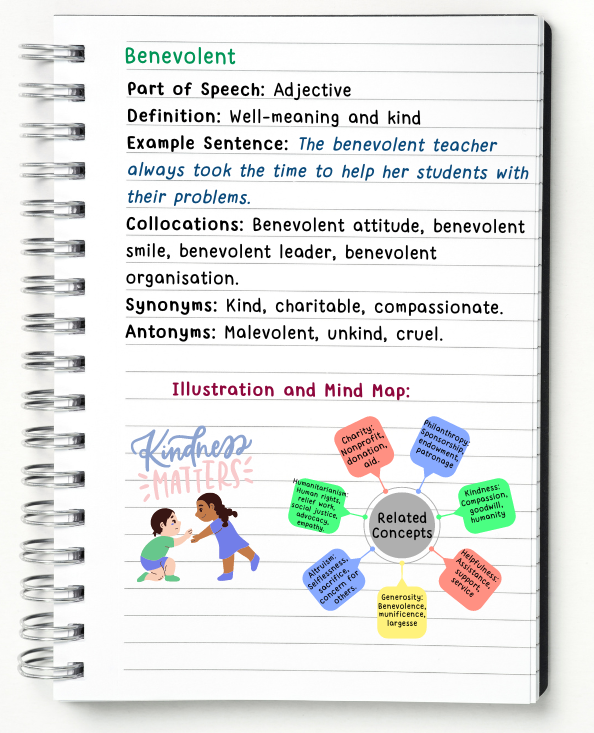Introduction
Vocabulary is the foundation of any language. The more words you know, the better you can understand and communicate. For language learners, building a robust vocabulary is essential for achieving fluency and confidence. One of the most effective ways to enhance your vocabulary learning is by mastering the art of how to organize a vocabulary book.
This article will guide you through the process of setting up and maintaining a vocabulary book, whether you’re a language learner yourself or a parent helping your child. We will cover everything from choosing the right book, setting it up, adding new vocabulary, and reviewing and practicing effectively. By the end of this article, you’ll have all the tools you need to master your vocabulary and boost your language skills.
The Importance of a Well-Organized Vocabulary Book
Vocabulary acquisition is a critical component of language learning. A well-organized vocabulary book not only helps in storing new words but also facilitates easy recall and practical application. When vocabulary is systematically organized, it aids in memory retention, making it easier to retrieve words when needed. Additionally, a structured vocabulary book provides a clear overview of your learning progress, highlighting areas of strength and those needing improvement. This organization transforms the often daunting task of vocabulary building into a manageable and rewarding activity.
Choosing the Right Vocabulary Book
Selecting the appropriate vocabulary book is the first step in creating an effective learning tool. There are various options available, from traditional notebooks and binders to digital apps. Consider the durability, ease of use, and portability of the book. Notebooks with sturdy covers and quality paper are ideal for long-term use. Binders with loose-leaf paper offer flexibility in rearranging sections. For tech-savvy learners, digital apps like Evernote, Quizlet, or dedicated vocabulary apps provide the convenience of accessing your vocabulary book anytime, anywhere. Each option has its pros and cons, so choose what best suits your learning style and preferences.
Setting Up Your Vocabulary Book
Organize your vocabulary book by dividing it into sections that make sense for your learning style. You can arrange sections alphabetically, by themes (such as travel, work, or food), or by parts of speech (nouns, verbs, adjectives). Use index tabs or color-coding to make navigation easy and quick.
Effective Techniques for Adding New Vocabulary
Building a robust vocabulary is a key component of language learning, and organizing your vocabulary book effectively can greatly enhance this process. Here are 7 key techniques to help you add new vocabulary in a structured and engaging manner:
1. Daily Vocabulary Collection Incorporate new words into your vocabulary book regularly. Identify and select new words from your reading materials, listening activities, or daily conversations. Encourage consistent vocabulary collection by setting aside a specific time each day to update your book. This habit ensures that you are continuously expanding your vocabulary and reinforcing new words.
2. Using Context Clues Understanding words in context is crucial. When you come across a new word, try to deduce its meaning from the surrounding text before looking it up. This practice enhances your ability to infer meanings and improves overall comprehension. Once you have a basic understanding, confirm the meaning by looking it up and adding it to your vocabulary book along with the context in which you found it.
3. Interactive Entries Make your entries more engaging by including illustrations, pictures, or mind maps. These visual aids can help reinforce the meaning of words and make your vocabulary book more enjoyable to use. For instance, you could draw a small picture representing the word, create a mind map connecting the word to related concepts, or even paste magazine cutouts that illustrate the word’s meaning.
4. Adding Detailed Word Information When adding a new word to your vocabulary book, it’s important to include comprehensive details to ensure thorough understanding and retention. Here are some elements to incorporate:
- Definition: Start with a clear and concise definition of the word. This helps solidify its meaning in your mind.
- Example Sentence: Write an example sentence using the word in context. This not only reinforces the meaning but also shows you how to use the word correctly.
- Collocations: Include common collocations (words that frequently go together with the target word). Understanding collocations can help you use the word more naturally and fluently.
- Synonyms and Antonyms: Adding synonyms and antonyms provides a deeper understanding of the word’s meaning and helps you expand your vocabulary further by learning related words.

5. Using Technology for Vocabulary Building Leverage technology to enhance your vocabulary learning experience. Use vocabulary apps and online dictionaries that provide audio pronunciations, example sentences, and related word suggestions. Many apps also offer spaced repetition systems (SRS) that remind you to review words at optimal intervals, helping to reinforce your memory.
6. Incorporating Word Families Understanding how words are related can help you learn and remember them more effectively. When you add a new word to your vocabulary book, also include its different forms (e.g., noun, verb, adjective, adverb). For example, if you’re learning the word “create,” you could also include “creation,” “creative,” and “creatively.” This approach helps you see the connections between words and expands your vocabulary more efficiently.
7. Using Flashcards Flashcards are a great tool for reinforcing new vocabulary. You can create physical flashcards or use digital flashcard apps like Anki or Quizlet. On one side of the flashcard, write the word and its definition, and on the other side, include an example sentence, synonyms, and antonyms. Regularly review your flashcards to keep the words fresh in your memory.

By employing these effective techniques, you can make the process of adding new vocabulary to your book more systematic and engaging. This structured approach will help you build a rich and varied vocabulary, enhance your language skills, and make your learning experience more enjoyable.
Reviewing and Practicing Vocabulary
Consistent review and active practice are crucial components of effective vocabulary learning. By regularly revisiting and using the words you’ve added to your vocabulary book, you can ensure long-term retention and fluency. Explore these strategies for reviewing and practicing your vocabulary: from scheduling regular review sessions using techniques like spaced repetition, to incorporating writing and speaking exercises into your routine, these methods will help reinforce your memory and enhance your language skills.
Regular Review Sessions: Consistent review is essential for long-term retention. Schedule regular sessions to go over your vocabulary entries. Techniques like spaced repetition, where you review words at increasing intervals, are highly effective. Flashcards and quizzes can also help reinforce your memory.
Practice Activities: Incorporate writing and speaking exercises into your practice routine. Write sentences, short paragraphs, or stories using new vocabulary. Practice speaking by using new words in conversations or storytelling. These activities help solidify your understanding and ability to use the words correctly.
Games and Apps: Utilize vocabulary-building games and apps to make learning fun and interactive. Recommendations include apps like Anki for flashcards and websites like Vocabulary.com for quizzes and games. These tools can add variety to your practice routine and keep you engaged.
Customizing the Vocabulary Book for Children
Making it Fun and Engaging: For children, the vocabulary book should be a fun and engaging tool. Use stickers, colorful pens, and fun illustrations to make entries visually appealing. Incorporate games and playful activities into vocabulary practice to keep children interested and motivated.
Parental Involvement: Parents can play a crucial role in their children’s vocabulary learning. Engage with your child’s vocabulary book by helping them select new words, reviewing entries together, and participating in practice activities. Activities such as flashcards, word games, and storytelling can be done together to reinforce learning.
Tracking Progress: Create a reward system to motivate children to keep up with their vocabulary practice. Use a progress chart to visualize achievements and set small, attainable goals to encourage consistent effort.
Overcoming Common Challenges
Consistency and Motivation: Maintaining a consistent practice routine can be challenging. Stay motivated by setting achievable goals and celebrating small wins. Keep your practice sessions varied and dynamic to prevent monotony. In addition, if you want to learn tips on gaining fluency, check out this article.
Dealing with Difficult Words: Some words can be particularly challenging to remember. Break down complex words into manageable parts and practice them in different contexts. Use mnemonic devices or associate the word with a visual image to aid memory.
Maintaining Interest: To keep the process engaging, periodically introduce new methods and tools. Rotate between different activities and formats to maintain interest and enthusiasm for vocabulary learning.
Integrating Technology
Digital Vocabulary Books: Digital tools offer numerous advantages for vocabulary learning, such as easy organization, accessibility, and the ability to incorporate multimedia elements. Apps like Evernote, Quizlet, and Anki allow you to create digital vocabulary books that can be accessed from any device. These tools also offer features like audio pronunciation, image integration, and interactive quizzes, making your learning experience more dynamic and effective.
Syncing Across Devices: One of the major benefits of digital vocabulary books is the ability to sync across multiple devices. This ensures that you can update and review your vocabulary entries anytime, anywhere, whether you’re on your computer, tablet, or smartphone. This convenience supports consistent practice and helps integrate vocabulary learning into your daily routine.
Combining Traditional and Digital Methods: While digital tools are highly effective, combining them with traditional methods can provide a comprehensive approach to vocabulary learning. For example, you might use a physical notebook for daily vocabulary collection and reflections, while relying on digital tools for review sessions and interactive practice. This blended approach allows you to leverage the strengths of both formats and tailor your learning process to your preferences.
Final Words
Learning how to organize a vocabulary book is an invaluable tool for language learners. By choosing the right book, setting it up effectively, and using it consistently, you can significantly enhance your vocabulary retention and recall. Regularly reviewing and practicing new words, customizing the process for children, and integrating technology are all strategies that can help you master your vocabulary and boost your language skills. Start organizing your vocabulary book today and transform your language learning journey into a more structured, efficient, and enjoyable experience.
We’d love to hear from you! Share your experiences and tips on organizing a vocabulary book in the comments section below. Your insights can help others in their language learning journey. Don’t forget to subscribe to our blog for more valuable language learning tips and resources. Stay tuned for more articles to help you enhance your English proficiency and achieve your learning goals!




